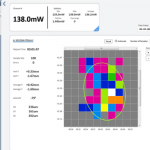Changes in technology are continually improving the face of manufacturing. The collection of data on a process is becoming less of a nicety and more of a necessity in this new industrial age.
Today, the continuous improvement of a process requires not only the collection of relevant data, but also analysis of that data so that adjustments can be made to the process and maintenance of process systems can be optimized.
Processes involving a laser require a number of variables to be measured and monitored apart from the laser, such as those related to materials and tooling. But variability of laser performance can often be the source of many problems to the laser operator since the tool involves invisible light being generated from a complex system.
Laser power meters and beam profilers have historically been an important part of the laser’s operation. The long-term collection of data about the laser’s performance will often provide the laser operator with indications when maintenance should be performed, in addition to a means of effectively and relatively quickly troubleshooting when problems arise with the system.
However, this equipment has typically been very delicate, not standing up to harsh production environments. They have also been relatively cumbersome to integrate into a laser cell. New technology has recently been introduced that addresses these challenges and overcomes these obstacles.
The Impact of Power Density
The performance of a laser being used for material processing can be generally defined as a function of its Power Density, expressed as “watts per centimeter squared” (W/cm2).
Regardless of the application of the laser system, to achieve the desired result each material has a specific power density at which the laser must be operated. For example, welding a metal may require kilowatts of laser power focused down to a spot size of a millimeter or less (in many cases) resulting in a Power Density of several megawatts per centimeter squared (MW/cm2).
If the laser power drops due to a faulty component or if the beam size at the work site increases due to thermal effects on the laser system, the Power Density will decrease and the ability of the laser to join the material is eventually reduced or eliminated.
Critical Laser Power Measurements
Although periodic collection of the laser power only paints part of the picture of the laser’s performance, most laser operators will agree that it is a vital indicator of how the overall laser system is processing its material. To be able to objectively verify laser power at the work site compared to the programmed laser power will ensure that the losses of laser power from the overall system are minimized.
A trend analysis of laser power measurements over time can be used to verify the stability of laser power which directly correlates to the overall health of the laser system. And obviously, a sudden loss of laser power will indicate a failure of a system component that might otherwise go unnoticed.
The question of how often laser power should be checked comes up frequently. Truth is, there are no set rules for how often a laser should be checked. Process specifications will call for the laser to be checked anywhere from several times a day to once a quarter, depending on the manufacturer’s needs.
That said, there are several times throughout a laser’s life when it should be measured. Laser power is most often verified (a) during the development of a new laser source, (b) when its application is developed, and (c) when it is integrated into a new system.
But for some reason, laser power checks are too often neglected once the laser is put into production for the last phase of its life. In reality, the investment into the laser process should be most protected at this time.

Maintenance Tool
There are typically three ways that a laser power meter should be used.
The most obvious and most frequent use is as a maintenance tool.
End users see the value of having a power meter on hand to make periodic checks of the laser system to ensure that laser health is consistent.
Laser power can also often be used to troubleshoot problems that arise with a laser process and help determine whether the laser source is the problem. These power meters are usually versatile and portable, and can be used on multiple laser systems.
One drawback that comes with these portable systems is that the laser must be taken out of production to perform the power check. Also, there are laser safety issues with the way the power meter is set up in relation to the laser system.
Trend Analysis
The most common way that a power meter is used with high-powered production lasers is trend analysis, which falls into two general categories: short- and long-term trend analysis. Short-term trend analysis evaluates the laser power from the time the laser is fired to several seconds after the laser is left on. A healthy laser will exhibit a plateaued laser power level that is close to the programmed laser power. Long-term trend analysis compares the laser power readings over long periods to ensure consistency and better verify process stability.
These two methods of trend analysis tell the laser user several things about the laser system. First, an unstable laser power reading from the time the laser fires to several seconds later can indicate a problem with the laser’s resonator. Also, a slow reduction in laser power over longer periods of time can warn the laser user of a degrading system component, such as an optic or window. Finally, a drastic reduction in laser power can tell the laser user of a catastrophically failed component. Power meters used for trend analysis are typically integrated devices which can call and log laser power to the laser’s HMI.
Go / No-Go Check
Lastly, a simple “go / no-go” check is done by some users. In this scenario, the power meter is used more frequently, closer to a part-to-part frequency, to verify that laser light is coming out of the system. An accurate power reading is not necessarily needed in this case, just a quick indication that the laser is functioning and fed back to the system to continue the process.
For example, the welding of an automobile’s frame is a crucial part of the production of the automobile. If, for some reason, the laser is inadvertently disabled, without a go / no-go check the welding routine may continue without the invisible laser light.
In this scenario, the frame welds must be reworked in order to maintain the automobile’s integrity.
This go / no-go check is not only a sanity check, but also an insurance policy for the laser welding process.

Integration in Harsh Production Environments
The design and integration of several hundred components to make up a system that processes material with a laser can be an overwhelming set of tasks. System integrators are continually looking for suppliers to provide them with components that easily and seamlessly fit into their designed system, both physically and logically.
The laser power meter should include IP-rated physical connections, designed to withstand harsh production environments with metallic laser process debris continuously contaminating the space. Its robust design will ensure longevity of use throughout the laser’s life. Industry-standard communication protocols must be considered as well. Typically, different countries will have different standards and practices. The U.S. largely uses Ethernet-IP communication with Profinet and RS232 in some cases. The power meter should be flexible enough to conform to the customer’s wishes regardless of the desired communication protocol.
Advances in Power Measurement
Recently, Ophir introduced a new industrial power meter to address the problems that industrial laser users are seeing when it comes to measuring laser power.
The Ophir IPM-10KW is a high power modular laser power sensor that delivers high accuracy and repeatable measurements in rough production environments. The system measures powers from 100W to 11kW for wavelengths from 900 to 1100nm and 10.6µm. The sensor is designed for manufacturers of laser-based machines for cutting and welding, as well as users who produce parts using these machines.
The IPM-10KW power meter is essentially two devices.
(1) At the core of the power meter is a water-cooled sensor with nickel-plated 12mm quick disconnects, rated for up to 11kW of laser power.
This sensor is the same advanced technology that many industrial customers have come to rely on for easy and accurate laser power measurements now housed in a rugged enclosure.
This sensor and the electronics needed to communicate with the laser system make up the base unit.
(2) The base unit communicates via RS232 with a “COM Box.” The COM Box communicates with the laser system via a choice of preferred communication protocols: EtherNet/IP, Profinet, or EtherCAT. For added protection of the laser sensor from industrial environments, there is also an optional electronically actuated shutter with a field-changeable protective AR-coated window.
Conclusion
The investment in a laser process should be protected, in part through the monitoring of its performance, ensuring that its process remains as consistent as possible over the longevity of the system’s life.
New developments in power meters provide an industrial-grade multi-kilowatt laser power meter, designed to be easily integrated, physically and logically, into a laser process cell.
This will help laser operators both know that the laser in their cell is performing consistently within design specifications and give them a means of more quickly troubleshooting problems that arise with the system.












Leave a Reply
Your email address will not be published. Required fields are marked *